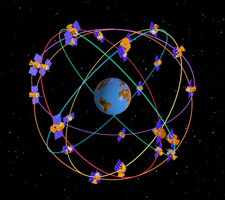April 24 (Bloomberg) -- China launched a satellite-killing
missile into space from a mobile platform that would make it
harder to destroy in a conflict, according to U.S. Air Force
Chief of Staff General Michael Moseley.
The Jan. 11 missile test revealed a capability that poses a
``significant risk to both civilian commercial systems and
military systems,'' Moseley said during a breakfast meeting with
reporters. ``The fact that it was mobile tells you a lot about
their ability to deploy and use it some where else,'' Moseley
said.
The missile test that destroyed an obsolete Chinese weather
satellite in low-earth orbit -- or up to 500 miles, where most
U.S. picture-taking spy satellites and commercial communications
satellites reside -- has drawn condemnation from several
nations, including Japan, Russia and the U.S. for introducing
weapons into space and adding to debris that can damage other
vehicles.
The test left a debris field of ``tens of thousands of
pieces,'' and ``China ought to be held accountable,'' said
Senator Bill Nelson, a Florida Democrat and a former astronaut,
at a Senate Armed Services Committee hearing today.
Moseley's remarks today where the first by a U.S. military
official on the record that said China used a mobile system and
fired a missile that shot straight up at the satellite.
``The fact that it was a `direct ascent' that was `boom' --
that was a good piece of work,'' Moseley said after the
breakfast in commenting on the technical prowess involved in the
test.
Hard to Destroy
Moseley's disclosure was significant, said Loren Thompson,
a defense analyst who follows military space subjects for the
Lexington Institute in Arlington, Virginia.
Moseley's comments mean ``it would be real hard to destroy
these mobile systems at the beginning of a war,'' Thompson said.
``The Russians and U.S. at the end of the Cold War were moving
to place all their nuclear weapons on mobile platforms because
they knew they'd be difficult to destroy,'' he said.
The U.S. in conflicts, including the 1991 Persian Gulf War
and 1999 bombing campaign in Kosovo, had major difficulties
tracking mobile tracks, he said.
Moseley said the Chinese missile test was ``a strategically
dislocating event'' on par with the Soviet Union's launch of the
Sputnik satellite in 1957, spurring a ``space race'' with the
U.S.
The thousands of debris pieces created by the shooting of
the satellite include about 1,700 measuring three centimeters or
more that the U.S. Strategic Command is capable of tracking,
Nelson said.
Avoiding Debris
Major General William Shelton, an official for the
Strategic Command, told the Senate Armed Services Committee on
April 19 that even pieces only of three-centimeters might cause
``catastrophic'' damage to satellites because of the speed at
which they move in space.
Nelson spokesman Barton Vaughan said in an e-mail statement
that the U.S. estimates ``tens of thousands of pieces larger
than one centimeter were created.'' U.S. satellites and the
International Space Station have been moved to avoid the debris,
he said.
The U.S. is especially vulnerable to interference with its
satellites because it is so dependent on them. Power, water
supply, gas and oil storage, banking and finance and government
services rely on satellite communications.
The military uses satellites for missile tracking,
intelligence gathering and secure voice communications.
Admiral Timothy Keating, head of the U.S. Pacific Command,
said he agreed with Nelson that holding China accountable for
any collateral damage caused by the debris it created ``is a
fair question'' that needs to be discussed.
Keating, in an interview after the hearing, said he was
going to talk with Chinese officials and reinforce the point
that the debris ``jeopardizes all manner of commercial and
military space vehicles.''

